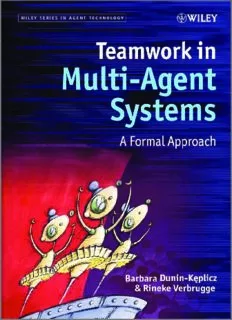Table Of ContentTEAMWORK
IN MULTI-AGENT
SYSTEMS
Wiley Series in Agent Technology
Series Editor: Michael Wooldridge, University of Liverpool, UK
The ‘Wiley Series in Agent Technology’ is a series of comprehensive practical guides
and cutting-edge research titles on new developments in agent technologies. The series
focuses on all aspects of developing agent-based applications, drawing from the Internet,
telecommunications, and Artificial Intelligence communities with a strong
applications/technologies focus.
The books will provide timely, accurate and reliable information about the state of the
art to researchers and developers in the Telecommunications and Computing sectors.
Titles in the series:
Padgham/Winikoff: Developing Intelligent Agent Systems 0-470-86120-7 (June 2004)
Bellifemine/Caire/Greenwood: Developing Multi-Agent Systems with JADE
0-470-05747-5 (February 2007)
Bordini/Hu¨bner/Wooldrige: Programming Multi-Agent Systems in AgentSpeak using
Jason 0-470-02900-5 (October 2007)
Nishida: Conversational Informatics: An Engineering Approach 0-470-02699-5
(November 2007)
Jokinen: Constructive Dialogue Modelling: Speech Interaction and Rational Agents
0-470-06026-3 (April 2009)
Castelfranchi/Falcone: Trust Theory: A Socio-Cognitive and Computational Model
0-470-02875-0 (April 2010)
Dunin–Ke¸plicz/Verbrugge: Teamwork in Multi-Agent Systems: A Formal Approach
0-470-69988-4 (June 2010)
TEAMWORK
IN MULTI-AGENT
SYSTEMS
A Formal Approach
Barbara Dunin-Ke¸plicz
WarsawUniversityand PolishAcademyofSciences
Poland
Rineke Verbrugge
UniversityofGroningen
TheNetherlands
A John Wiley and Sons, Ltd., Publication
Thiseditionfirstpublished2010
2010JohnWiley&SonsLtd
Registeredoffice
JohnWiley&SonsLtd,TheAtrium,SouthernGate,Chichester,WestSussex,PO198SQ,UnitedKingdom
Fordetailsofourglobaleditorialoffices,forcustomerservicesandforinformationabouthowtoapplyforpermissionto
reusethecopyrightmaterialinthisbookpleaseseeourwebsiteatwww.wiley.com.
TherightoftheauthortobeidentifiedastheauthorofthisworkhasbeenassertedinaccordancewiththeCopyright,
DesignsandPatentsAct1988.
Allrightsreserved.Nopartofthispublicationmaybereproduced,storedinaretrievalsystem,ortransmitted,inany
formorbyanymeans,electronic,mechanical,photocopying,recordingorotherwise,exceptaspermittedbytheUK
Copyright,DesignsandPatentsAct1988,withoutthepriorpermissionofthepublisher.
Wileyalsopublishesitsbooksinavarietyofelectronicformats.Somecontentthatappearsinprintmaynotbeavailable
inelectronicbooks.
Designationsusedbycompaniestodistinguishtheirproductsareoftenclaimedastrademarks.Allbrandnamesand
productnamesusedinthisbookaretradenames,servicemarks,trademarksorregisteredtrademarksoftheirrespective
owners.Thepublisherisnotassociatedwithanyproductorvendormentionedinthisbook.Thispublicationisdesigned
toprovideaccurateandauthoritativeinformationinregardtothesubjectmattercovered.Itissoldontheunderstanding
thatthepublisherisnotengagedinrenderingprofessionalservices.Ifprofessionaladviceorotherexpertassistanceis
required,theservicesofacompetentprofessionalshouldbesought.
LibraryofCongressCataloging-in-PublicationData
Dunin-Keplicz,Barbara.
Teamworkinmulti-agentsystems:aformalapproach/BarbaraDunin-Keplicz,RinekeVerbrugge.
p.cm.
Includesbibliographicalreferencesandindex.
ISBN978-0-470-69988-1(cloth:alk.paper)1.Intelligentagents(Computersoftware)2.Formalmethods(Computer
science)3.Artificialintelligence.I.Verbrugge,Rineke.II.Title.
QA76.76.I58D982010
006.3–dc22
2010006086
AcataloguerecordforthisbookisavailablefromtheBritishLibrary.
ISBN978-0-470-69988-1(H/B)
Typesetin10/12TimesbyLaserwordsPrivateLimited,Chennai,India.
PrintedandBoundinSingaporebyMarkono
To Maksymilian
To Nicole
Contents
About the Authors xiii
Foreword xv
Preface xvii
1 Teamwork in Multi-Agent Environments 1
1.1 Autonomous Agents 1
1.2 Multi-Agent Environments as a Pinnacle of Interdisciplinarity 2
1.3 Why Teams of Agents? 2
1.4 The Many Flavors of Cooperation 3
1.5 Agents with Beliefs, Goals and Intentions 4
1.6 From Individuals to Groups 4
1.7 Group Attitudes 5
1.8 A Logical View on Teamwork: TEAMLOG 5
1.9 Teamwork in Times of Change 6
1.10 Our Agents are Planners 7
1.11 Temporal or Dynamic? 8
1.12 From Real-World Data to Teamwork 9
1.13 How Complex are Models of Teamwork? 10
2 Beliefs in Groups 11
2.1 Awareness is a Vital Ingredient of Teamwork 11
2.2 Perception and Beliefs 12
2.3 Language and Models for Beliefs 13
2.3.1 TheLogical Language for Beliefs 13
2.3.2 KripkeModels for Beliefs 14
2.4 Axioms for Beliefs 14
2.4.1 Individual Beliefs 15
2.4.2 From Generalto CommonBelief 16
2.5 Axioms for Knowledge 18
2.6 Relations between Knowledge and Belief 20
2.7 Levels of Agents’ Awareness 21
viii Contents
2.7.1 Intra-Personal Awareness 21
2.7.2 Inter-PersonalAwareness 23
2.7.3 GroupAwareness 24
2.7.4 Degreesof Beliefsin a Group 25
3 Collective Intentions 29
3.1 Intentions in Practical Reasoning 29
3.1.1 MovingIntentions to the Collective Level 31
3.2 Language and Models for Goals and Intentions 32
3.2.1 TheLogical Language 32
3.2.2 KripkeModels 32
3.3 Goals and Intentions of Individual Agents 33
3.3.1 InterdependenciesbetweenAttitudes 34
3.4 Collective Intention Constitutes a Group 36
3.5 Definitions of Mutual and Collective Intentions 37
3.5.1 Some Examples 39
3.5.2 CollectiveIntentions Allow Collective Introspection 40
3.6 Collective Intention as an Infinitary Concept 40
3.6.1 Mutual Intention is Createdin a Finite Numberof Steps 41
3.6.2 Comparison withthe One-LevelDefinition 41
3.6.3 Comparison withthe Two-LevelDefinition 42
3.6.4 Canthe Infinitary Conceptbe Replacedby aFinite
Approximation? 43
3.7 Alternative Definitions 43
3.7.1 RescueSituations 43
3.7.2 TuningGroup Intentions to the Environment 45
3.8 The Logic of Mutual Intention TeamLogmint is Complete 45
3.9 Related Approaches to Intentions in a Group 52
3.9.1 WhatNext? 53
4 A Tuning Machine for Collective Commitments 55
4.1 Collective Commitment 55
4.1.1 Gradations of Teamwork 55
4.1.2 CollectiveCommitmentTriggers Team Action 56
4.1.3 A TuningMechanism 56
4.2 The Language and Kripke Semantics 57
4.2.1 Language 57
4.2.2 KripkeModels 59
4.3 Building Collective Commitments 60
4.3.1 Social Plans 60
4.3.2 Social Commitments 61
4.3.3 Deontic Aspectsof Social Commitments 62
4.3.4 CommitmentStrategies 63
4.4 Tuning Collective Commitments 63
4.4.1 WhyCollective Commitment? 63
4.4.2 GeneralSchemaofCollective Commitment 65
Description:What makes teamwork tick?Cooperation matters, in daily life and in complex applications. After all, many tasks need more than a single agent to be effectively performed. Therefore, teamwork rules!Teams are social groups of agents dedicated to the fulfilment of particular persistent tasks. In modern

